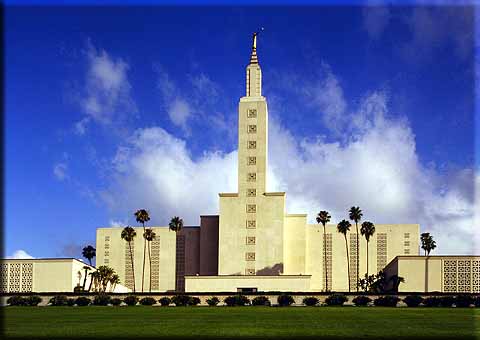 |
  
History of the California Los Angeles Mission
From the early days of the western movement of the Church, California has been viewed as a land of special destingyand promise for The Chruch of Jesus Christ of Latter-day Saints. In Feburary of 1844, the Prophet Joseph Smith asked that California and Oregon be investigated as potential settlement areas for the Church where it could grow without the persecution recieved in the eastern lands. Two years later, two major efforts to explore and colonize California were led from two opposite ends of the country. James K. Polk, then President of the United States, commissioned 400 men from Nauvoo to establish stockade forts from Iowa to Oregon. These were to be led by their own officers and became know as the Mormon Battalion. Meanwhile, 239 saints left New York and sailed around Cape Horn in search of the Pacific Coast. They were led by 27-year-old Samuel H. Brannan who was set apart prior to his departure as leader and Presiding Elder for the Pacific Colonies. Both groups seemed to be reponding to Brigham Young's prophetic statement, "Let the Mormons be the first to set their feet on the soil of California!"
It was July 21, 1846, when the passenger ship "Brooklyn," under the command of Samuel Brannan, landed in San Fracnisco--the first immigrant ship ever to land on the Pacific Coast. Upon it's arrival, President Brannan established the California Mission, the fifth formally established mission of the young Church. It was about that time that the Mormon Battalion left Council Bluffs, Iowa, on the longest and hardest infantry march in the history of the United States, arriving in California in January 1847, and terminating in March of the same year. With these two groups, the Mormons made up a sizeable portion of the California population.
By August 1847, the Salt Lake Valley was an established settlement for the saints, and President Brigham Young desired to make it the single largest gathering place for the saints, maintaining the California outposts as only stopping points. He said: "It is not that we wish to depopulate California of all the saints..in the process of time the shores of the Pacific may be overlooked from the temple of the Lord. It is desirable that there be a stopping place for the saints west of the mountains where those arriving from the east coast may locate."
While many of those from the two companies did continue on to Salt Lake, many others remained in California. It was in Janurary of 1848 that some of the men from the Mormon Battalion discovered gold at Sutter's Mill. The discovery of gold greatly changed the nature of the California settlement, as San Francisco jumped from a population of 800 in 1848, to several thousands by the height of the 1849 gold rush. Concerned by the worldiness and the sin-minded state of the gold rush, President Young encouraged the saints to return to Salt Lake City.
Samuel Brannan became so involved in the gold rush that he forsook his church responsibilites, and eventually apostatized from the Church. He was replaced was replaced by two apostles, Elder Charles Rich and Elder Amasa Lyman, who jointly took the presidency of the California Mission in 1849. The two men established and settled the town of San Bernardino with Brigham's reluctant approval. That same year, Apostle Parley P. Pratt arrived in San Francisco where he served two terms as President of the California Mission. Elder Pratt wrote the book Keys to Theology durig his mission. Mission was furnished with short-time missionaries who were awaiting passage to the South Pacific. In September 1857, the controversy over the issue of polygamy had become so intense that President Young ordered all missionaries to return home. The California Mission remained closed until 1890 when the first missionaries returned in 1892 the mission was again formally organized.
The reorgainization of the misison began the real growth of the mission, as the Church membership increased from 147 in 1895, to 448 in 1900, 107 of which were located in Los Angeles. A milestone was reached on March 21, 1895, when the Los Angeles Branch was organized. On November 23, 1919, the Long Beach Branch was organized, and on May 16, 1920, the Santa Monica Branch was organized. In Janurary 1923, over 4,000 members of the 16 branches in the area formed the Los Angeles Stake of Zion, the 88th stake organized in the last dispensation and the first one on the west coast. The first chapel (built in 1923), the Adam Stake Center, was the first Latter-day Saint meetinghouse to be built by the saints in Southern California.
San Franciso was so devastated by the earthquake of 1906 that the headquarters of the mission was relocated to Los Angeles. By 1940 there were 12 stakes in the State of California, and in 1942, the California Mission was divided, creating the Northern California Mission.
After the completion of the Los Angeles Temple in 1955, mission headquarters was moved to its present location. By 1965 there were 55 stakes in California, and in 1966 and 1969, two more missions, the California South and the California East Missions, were created. In 1974 the name of the mission was changed to the California Los Angeles Mission and the Ventura Mission was created in 1978. With the creation of the California Riverside Mission in 1990, there are now 12 Mission in California. Today, misisonaries of the California Los Angeles Mission teach the restored Gospel of Jesus Christ in more than nine different languages and cultures, baptizing an average of 100 people per month in three regions and fourteen stakes of Zion.
Taken from The California Los Angels Mission Missionary Manual, written in 1995
|
|
|
 |
 |


